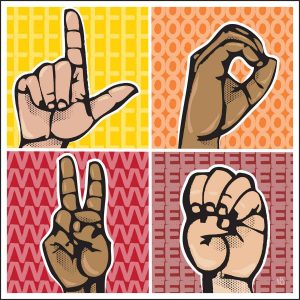Sharing Christ with the Deaf community
Many Christians unwittingly overlook the world’s third-largest unreached people group, many of whom live in the US. Although this group shares many similarities with the rest of us, their culture and language differ significantly from ours.
Although natural-born citizens, Americans who are deaf enjoy little access to the gospel. The US Census Bureau estimates that 13 percent of the US population has some degree of hearing loss, ranging from slight hearing impairment to profound deafness. That’s one out of every eight Americans.

“Deaf” with a capital D refers to the people group that communicates via sign language. Deaf people hold a set of beliefs about themselves and how they connect to the larger society, and their unique culture distinguishes them from hearing people. Just as we capitalize “Hispanic,” or “African American,” we capitalize “Deaf” to indicate their distinct culture. Lowercase “deaf” is an adjective that describes people who have lost their hearing.
Deaf culture is intimately linked to the use of American Sign Language (ASL). If a deaf person uses ASL as her primary means of communication, the Deaf embrace her as “Deaf.” If a deaf person chooses not to use ASL, the community perceives him as “hearing-minded,” behaving as a hearing person would.
Because ASL is a cultural distinctive for the Deaf, Christians should understand some basic rules about the language. First, researchers have established that using ASL triggers the same portions of the brain as spoken languages. ASL is not simply coded English but has its own syntax. For example, instead of signing, “The boy goes to the store,” the Deaf will sign, “Store boy goes.” Just as languages evolve from complex to simple, so do signs. Two-handed signs often evolve to one-handed signs. Signs requiring multiple movements soon reduce to one movement.
Second, Deaf people in other countries use their own distinct sign language. A Deaf person in France, for example, uses French Sign Language, a completely separate language from ASL. A Peruvian uses a different sign language from a Mexican. Sometimes, two distinct sign languages emerge from one spoken language. The signs in northern Spain, for example, differ from those in southern Spain.
Over 90 percent of Deaf children have hearing parents. Typically, hearing family members do not learn ASL. By default, the responsibility to communicate falls on the Deaf person. He or she must lip-read, gesture, or write back and forth. This burden quickly acts like a muzzle, and conversations with family members turn superficial and brief.
But conversation with other Deaf penetrates deeper territory. Since no barriers hinder communication, Deaf people often feel closer to their Deaf friends than to their hearing family. They love participating in Deaf events where they can meet new Deaf people and stay informed about the Deaf community. They will remain loyal to other Deaf for the rest of their lives.
Once we recognize the Deaf as a distinct people group, we understand that the Great Commission includes them as much as it does any nationality. Before ascending into heaven, Jesus left his followers with one charge—multiply (Matthew 28:18–20).
When we wear our 21st-century ears, we hear “nation” and think “country.” Matthew’s readers, however, had a different idea of “nation” from ours. In fact, according to the standard biblical Greek lexicon, the Greek word for “nation” most often refers to “a body of persons united by kinship, culture, and common traditions.” Using this definition, clearly the Deaf count as a “nation.” If Jesus’ command extended to Matthew’s readers, it also extends to us.
When two cultures converge, misunderstandings will occur. Loving people well—especially across cultures—also takes time. But we can all take small steps towards fulfilling the Great Commission among the Deaf, and we can start by approaching them with humility, a willingness to learn from them, and the flexibility to adapt our outreach methods.
Love Your Deaf Neighbors as Yourself
• Understand their daily life: Most Deaf people install flashing alarms in their houses so that they can see sounds—the doorbell ringing or the fire alarm sounding. To wake up, they often use a vibrating alarm clock that shakes the entire bed. Some use trained dogs that wag their tails or nudge their owner to notify them of various sounds, like the microwave dinging, a baby crying, or a police siren.
• Enter their personal space: Hearing people can talk to each other from a distance, but Deaf people have very different rules for personal space. They wave, tap, or throw a Nerf ball across the room to grab their friend’s attention. Offer consistent eye contact and visual attention when talking with a Deaf person, responding with facial expressions to show you are engaged in the conversation.
• “Talk” to them on the phone: A videophone allows Deaf people to chat through a camera mounted to their TV—similar to Skype, but without the audio. A Deaf person who wants to talk to a hearing person (or vice versa) will use a videophone to call through a relay service. They sign to the interpreter on the screen, and the interpreter voices their message to the hearing person. The interpreter then signs the hearing person’s reply.
Deaf culture is expressed through films, folklore, literature, dance, athletics, poetry, celebrations, clubs, organizations, theaters, and school reunions.
To learn more about Deaf culture, check out some of the following resources:
“But I don’t know sign language”
You can get involved with the Deaf even if you don’t know sign language. Consider the following options:
• Does your church have a Deaf ministry? If so, you have access to Deaf people every week. Why not sit with the Deaf members of your church or try signing the worship songs? Although it is important to learn ASL and to be sensitive to Deaf culture, friendliness can communicate your love regardless of your native language. I remember one of the greeters at my home church intentionally shaking the hands of the Deaf people who arrived. A smile, a wave, a handshake, or a hug welcomes the Deaf person into your congregation. Invite them to coffee, arrange a playdate between their kids and yours. Too often hearing people—because they don’t know what to do or are afraid they’ll do it “wrong”—make no overtures to the Deaf, but doing something trumps doing nothing every time.
• Does your church hold outreach events for the community? Consider hiring an interpreter and letting the community know interpretation will be available. You can also partner with a local Deaf church (or a hearing church with a Deaf ministry) and plan the event together. Even if no Deaf attend, your congregation will broaden their perspective on discipleship.
• Help your church consider adding Deaf missionaries to their support work. Some mission agencies have groups within their organization that reach out to the Deaf. DOOR (Deaf Opportunity OutReach) International exists to bring God’s Word and Christian fellowship to Deaf communities worldwide. Wycliffe utilizes Deaf signers from around the world to help them translate Scripture into various signed languages. Deaf Missions strives to equip Deaf pastors and teachers with online resources. Deaf GO! takes the gospel to international Deaf living in the United States.
• Have you ever wanted to learn ASL? Take a class or two at a community college. After learning some basic vocabulary and grammar, volunteer with Deaf elementary students or Deaf senior citizens. Both groups will welcome the company.
Carole Brenton, a member of Wycliffe USA assigned to support the work of DOOR International in Africa, has worked with and among the Deaf in the US for the past 35 years. “Deaf people are usually the last to know anything,” she explains. “They don’t overhear anything, and they frequently struggle with reading. As a result, the Deaf have many misunderstandings about God and the Bible.” (See “Can’t They Just Read the Bible?“) The work of missionaries like Brenton would be much easier if the rest of us were already sharing the love of God with our Deaf neighbors.
Whenever Christians engage the Deaf sensitively and respectfully, their efforts please Christ. To fulfill Christ’s mandate, believers must engage the Deaf community. Regardless of Christians’ initial knowledge of sign language or Deaf culture, all of us can take steps to educate ourselves and to disciple the Deaf.
Sarita Fowler has worked as an American Sign Language interpreter for the Deaf and served in the Deaf ministry of her church. She recently completed a Master of Theology program at Dallas Theological Seminary.


